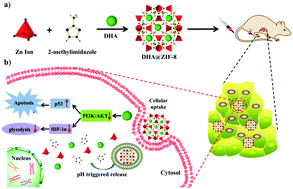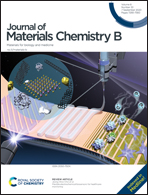MOF nanoparticles with encapsulated dihydroartemisinin as a controlled drug delivery system for enhanced cancer therapy and mechanism analysis†
Abstract
Dihydroartemisinin (DHA) has attracted increasing attention as an emerging therapeutic agent for tumor treatment. However, the clinical application of DHA is seriously limited owing to its inherent properties, including low solubility, poor selectivity, and fast clearance. Herein, we report a facile yet efficient strategy based on using zeolitic imidazolate framework-8 to load DHA (DHA@ZIF-8). The as-prepared DHA@ZIF-8 nanoparticles (NPs) possess high drug encapsulation efficiency (77.2%), favorable stability, good biocompatibility and controllable drug release in tumor acidic microenvironments. DHA@ZIF-8 NPs exhibit enhanced antitumor effects compared with free DHA in in vitro and in vivo therapy experiments, accompanied with negligible side effects. Furthermore, the antitumor mechanism of DHA@ZIF-8 NPs is well investigated by RNA sequencing (RNA-seq) and bioinformatics analysis. The results indicate that DHA@ZIF-8 NPs modify the expression of 7090 genes in HepG2 cells, and the mechanism may be related to the induction of apoptosis through a p53-mediated mitochondrial pathway and the suppression of glycolysis by inhibiting the PI3K/AKT pathway. This work highlights the potential of utilizing MOFs as a safe and stable platform for developing a highly efficient drug delivery system in cancer therapy, and the investigation of the antitumor mechanism can provide theoretical support for the clinical usage of DHA.



 Please wait while we load your content...
Please wait while we load your content...